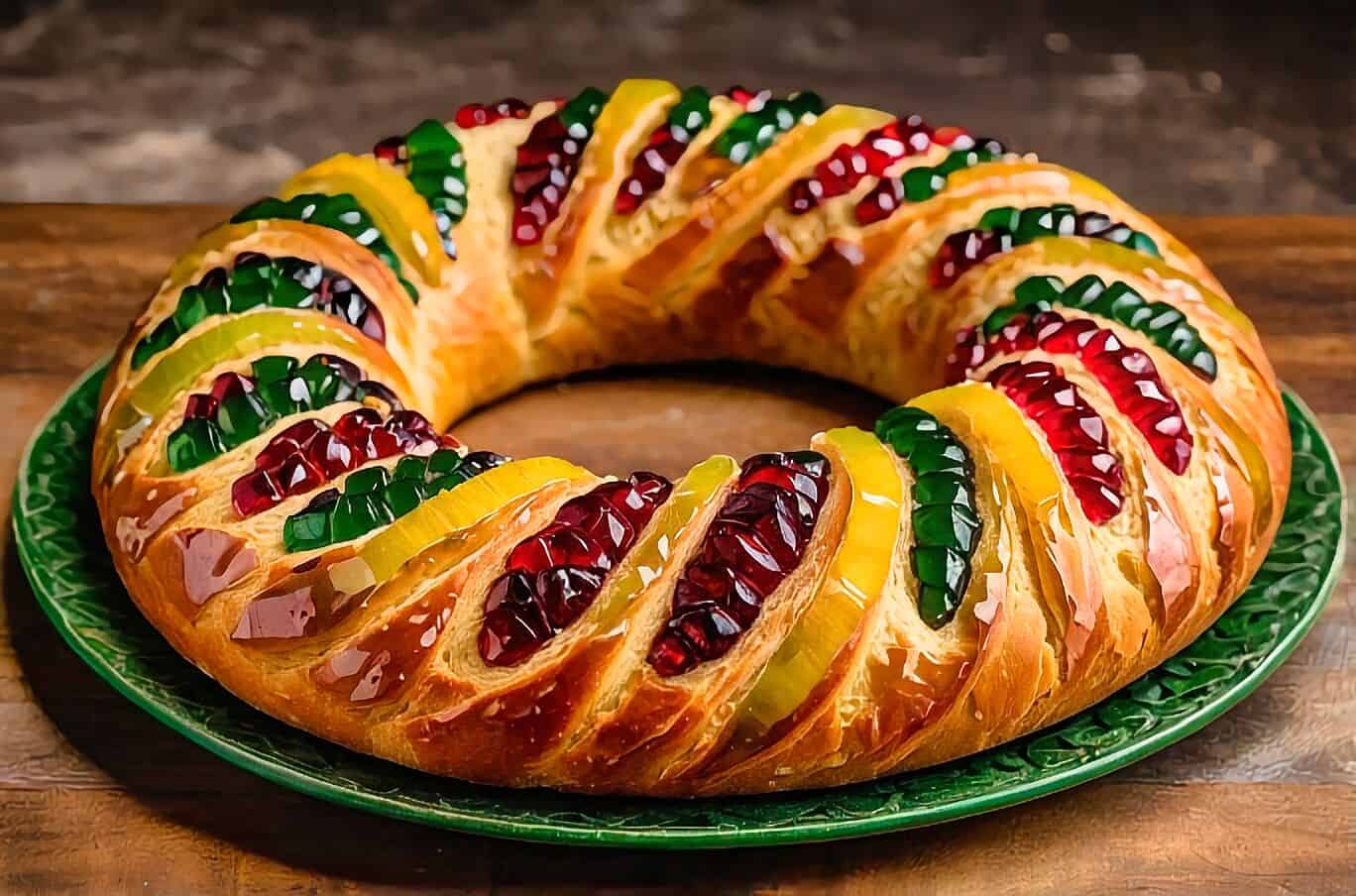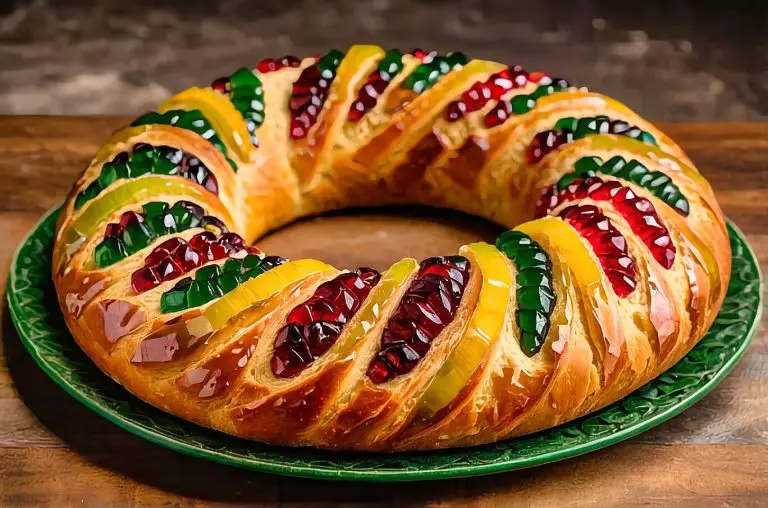The Rosca de Reyes recipe (Three Kings Bread) is a traditional Mexican pastry made for Epiphany on January 6th. This festive bread is characterized by its sweet, buttery flavor and its distinctive ring shape, symbolizing a crown. The bread may have candied fruits (the jewels of a crown) or a small figurine of baby Jesus inside.
The Rosca de Reyes recipe is made by making a yeasted dough. The dough is generally made with flour, butter, eggs, sugar, and whole milk with a hint of citrus zest. Orange or lime zest lends a subtle citrus note to the bread. The dough is kneaded till elastic and smooth and let rise until double in size.
Once risen, the dough is shaped into a large ring, a crown. The bread is often adorned with candied fruits (cherries, pineapple, figs) that are shaped like crown jewels before baking. A number of variations of the bread might also have a sweet glaze or a streusel topping for flavor and crunch.
The the Rosca de Reyes recipe must be baked at the right temperature and the right time for a golden-brown crust and a soft, fluffy interior. The bread is usually baked at a moderate temperature until of desired color and texture.
A small image of baby Jesus is usually placed inside the bread before it bakes. The person who finds the figurine in their slice is expected to host a party or make tamales for the group on Da de la Candelaria on February 2nd. This tradition adds surprise and community to the celebration.
The Rosca de Reyes recipe is often paired with a hot beverage, like Mexican hot chocolate or atole during Epiphany celebrations. The bread is generally cut into slices and each piece has somewhat of a sweet, buttery taste together with the occasional candied fruit or maybe the figurine.
Finally, Rosca de Reyes is more than a pastry; it’s more than a pastry. it is a tradition to celebrate Epiphany together. Its history, flavor, and festive appearance make it a centerpiece of Mexican culinary heritage.
Ingredients For the Mexican Rosca de Reyes Recipe
Bread
½ cup Water, warm
2 ¼ tsp Active Yeast
4 cups All-purpose Flour, plus 2 or 3 Tbsp. more for dusting
¾ cup Sugar, if you want sweeter add ¼ cup extra.
3 Eggs, LARGE
3 Egg Yolks, mixed with 4 Tablespoons of milk
¼ tsp Salt
1 ½ tbsp Orange Extract
1 ½ stick Butter, unsalted plus more for the mixing bowl and plastic wrap.
1/2 cup Orange Zest, grated
Toppings
1 Egg Yolk
¾ cup All-purpose Flour
6 tablespoons Margarine
½ cup Sugar, confectioner
Dry fruit like figs candied citron, quince paste stripes, orange peels or cherries.*
1 Egg, beaten for glazing the bread
1 tbsp Whole Milk
1/4 cup White Sugar, to sprinkle on top of the bread
2 or 3 plastic Baby Dolls
Cooking Instructions For the Mexican Rosca de Reyes Recipe
Introduce lukewarm water into a bowl and add yeast over it. Mix with a fork until the yeast is fully dissolved, then allow it rest until frothy, approximately 5 to 10 minutes. Incorporate ½ cup of the flour and cover the bowl with plastic wrap. Allow to rest in a warm location until it has doubled in volume, approximately 25 minutes.
Simultaneously, combine flour, eggs, egg yolks, sugar, orange extract, orange zest, salt, and butter in a large bowl. Combine until a crumbly texture is achieved. Although I possess a stand mixer, I choose to knead the dough by hand, considering that not everyone has access to a large mixer; nonetheless, these processes can also be performed using a KitchenAid.
Incorporate the yeast mixture into the bowl and combine thoroughly. It will be somewhat adhesive yet manageable; incorporate flour if necessary. Transfer to a lightly floured surface and commence kneading until a smooth dough is achieved. The results will require approximately 15 to 20 minutes to obtain. Seven minutes in your KitchenAid. Avoid adding excessive flour to your workspace; the texture should remain very soft, somewhat moist yet controllable. Excessive flour will result in dry bread.
After achieving a smooth and pliable dough, transfer it to a buttered bowl and cover with buttered plastic wrap. T Allow the dough to rest in a warm environment until it has doubled in volume, approximately 1.5 hours. Ensure your kitchen is adequately heated to facilitate the rising of your dough. If the dough does not double in volume within this timeframe, allow it to rest for an extended period. The fermenting process enhances flavor; hence, a slower and prolonged duration is preferable.
During the dough’s resting period, combine margarine with confectioner’s sugar until a creamy consistency is achieved. Subsequently, incorporate the flour and egg yolk. Continue until a homogeneous paste is achieved.
Before the initial restig interval, transfer the dough onto a lightly floured surface, knead briefly, then form it into a circular cushion and create a hole in the center to shape it into a huge ring. Transfer to a greased rimmed baking sheet and loosely cover with buttered plastic wrap. Allow to rise in a warm location for 45 minutes or longer, until nearly doubled in volume. Collect all your embellishments and the egg wash. For the egg wash, combine the remaining egg with milk or water using a whisk.
Preheat the oven for a minimum of 20 minutes prior to baking at 375 degrees, ensuring the rack is positioned in the lower third.
Apply the egg wash to the dough twice for a beautiful crust. Shape strips using the confectioner’s sugar paste and embellish the dough. Incorporate a portion of the dried fruit by pushing it lightly into the dough. Dust with sugar and bake for 10 minutes. Lower the temperature to 350 degrees and continue baking for an additional 10 minutes until the bread attains a pleasing golden brown hue. Depending on your oven, additional time may be necessary. Several readers reported baking for 30 minutes.
Relocate the bread to a wire rack for cooling. Once the bread has cooled, insert the plastic baby dolls from the base of the loaf. Ensure that your guests are informed about the presence of a baby toy within the bread. Rosca de Reyes may be preserved in an airtight container for a duration of up to 3 days.
Helpful Suggestions For the Mexican Rosca de Reyes Recipe
To craft an authentic Mexican Rosca de Reyes, attention to detail and patience are essential. Begin by ensuring all ingredients, particularly eggs and butter, are at room temperature; this facilitates better integration and a smoother dough consistency. When preparing the dough, incorporate citrus zest, such as orange and lime, to impart a traditional aromatic flavor.
Knead the dough on a floured surface for 10-15 minutes until it becomes smooth and elastic, indicating proper gluten development. Allow the dough to rise in a warm, draft-free environment until it doubles in size, which typically takes about 1 to 1.5 hours. After the initial rise, shape the dough into a large ring, symbolizing a king’s crown, and insert small figurines or dried beans to adhere to tradition. For decoration, arrange candied fruits and nuts atop the dough to represent the jewels of the crown. Before baking, let the shaped dough undergo a second rise to ensure a light and airy texture in the final product.
Bake the Rosca de Reyes in a preheated oven at 350°F (175°C) until it achieves a golden-brown hue, typically around 25 to 30 minutes. Once baked, allow it to cool on a wire rack before serving. This meticulous process results in a festive bread that is both visually appealing and delightful in flavor.
Storage Instructions For the Mexican Rosca de Reyes Recipe
Proper storage of Rosca de Reyes is crucial to maintain its freshness and quality. After baking, allow the bread to cool completely to room temperature on a wire rack; this prevents condensation, which can lead to sogginess. Once cooled, place the Rosca de Reyes in an airtight plastic storage bag or wrap it tightly with plastic wrap to shield it from air exposure, which can cause staleness.
Store the wrapped bread at room temperature in a cool, dry place away from direct sunlight. Under these conditions, the Rosca de Reyes can remain fresh for up to two to three days. For extended storage, freezing is recommended. Wrap the cooled bread securely in plastic wrap, followed by a layer of aluminum foil, to prevent freezer burn. Place the wrapped bread in a freezer-safe bag or container and store it in the freezer for up to two months. When ready to enjoy, thaw the Rosca de Reyes at room temperature, keeping it wrapped to retain moisture.
Once thawed, you may refresh it by warming it in a preheated oven at 300°F (150°C) for about 10 minutes to restore its softness and enhance its aroma. Avoid refrigerating the bread, as this can accelerate the staling process due to the cool temperatures causing the starches to recrystallize more rapidly.
FAQ For the Mexican Rosca de Reyes Recipe
Question: What is the significance of the figurines hidden in a Mexican Rosca de Reyes recipe?
A: In a Mexican Rosca de Reyes recipe, small figurines, often representing the baby Jesus, are hidden within the dough. Traditionally, whoever finds a figurine in their slice is expected to host a celebration on Día de la Candelaria (Candlemas Day) on February 2nd.
Question: Can I prepare the dough for a Mexican Rosca de Reyes recipe in advance?
A: Yes, you can prepare the dough for a Mexican Rosca de Reyes recipe in advance. After the initial rise, punch down the dough, cover it with plastic wrap, and refrigerate it overnight. This slow fermentation enhances the flavor. Before shaping and baking, allow the dough to come to room temperature and complete the second rise.
Question: What types of candied fruits are traditionally used in a Mexican Rosca de Reyes recipe?
A: Traditional Mexican Rosca de Reyes recipes often feature candied fruits such as figs, cherries, and citrus peels. These colorful toppings symbolize the jewels of a king’s crown and add sweetness and texture to the bread.
Question: How can I ensure a soft and moist texture in my Mexican Rosca de Reyes recipe?
A: To achieve a soft and moist texture in your Mexican Rosca de Reyes recipe, ensure proper kneading to develop gluten, allow adequate rising times for fermentation, and avoid overbaking. Incorporating ingredients like butter and milk also contributes to the bread’s tenderness.
Question: Is it possible to add fillings to a Mexican Rosca de Reyes recipe?
A: While traditional Mexican Rosca de Reyes recipes do not include fillings, some variations incorporate fillings such as cream cheese, chocolate, or fruit preserves to add flavor and moisture. If adding a filling, ensure it is evenly distributed and does not overly moisten the dough, which could affect baking.

Great Rosca de Reyes Recipe
Ingredients
Bread
- ½ cup Water warm
- 2 ¼ tsp Yeast Active
- 4 cups All-purpose Flour plus 2 or 3 Tbsp. more for dusting
- ¾ cup Sugar if you want sweeter add ¼ cup extra.
- 3 Eggs LARGE
- 3 Egg Yolks mixed with 4 Tablespoons of milk
- ¼ tsp Salt
- 1 ½ tbsp Orange Extract
- 1 ½ Butter unsalted plus more for the mixing bowl and plastic wrap.
- 1/2 cup Orange Zest grated
Toppings
- 1 Egg Yolk
- ¾ cup All-purpose Flour
- 6 tablespoons Margarine
- ½ cup Sugar confectioner
- Dry fruit like figs candied citron quince paste stripes, orange peels or cherries.*
- 1 Egg beaten for glazing the bread
- 1 tbsp Whole Milk
- 1/4 cup White Sugar to sprinkle on top of the bread
- 2 or 3 plastic Baby Dolls
Instructions
- Introduce lukewarm water into a bowl and add yeast over it. Mix with a fork until the yeast is fully dissolved, then allow it rest until frothy, approximately 5 to 10 minutes. Incorporate ½ cup of the flour and cover the bowl with plastic wrap. Allow to rest in a warm location until it has doubled in volume, approximately 25 minutes.
- Simultaneously, combine flour, eggs, egg yolks, sugar, orange extract, orange zest, salt, and butter in a large bowl. Combine until a crumbly texture is achieved. Although I possess a stand mixer, I choose to knead the dough by hand, considering that not everyone has access to a large mixer; nonetheless, these processes can also be performed using a KitchenAid.
- Incorporate the yeast mixture into the bowl and combine thoroughly. It will be somewhat adhesive yet manageable; incorporate flour if necessary. Transfer to a lightly floured surface and commence kneading until a smooth dough is achieved. The results will require approximately 15 to 20 minutes to obtain. Seven minutes in your KitchenAid. Avoid adding excessive flour to your workspace; the texture should remain very soft, somewhat moist yet controllable. Excessive flour will result in dry bread.
- After achieving a smooth and pliable dough, transfer it to a buttered bowl and cover with buttered plastic wrap. T Allow the dough to rest in a warm environment until it has doubled in volume, approximately 1.5 hours. Ensure your kitchen is adequately heated to facilitate the rising of your dough. If the dough does not double in volume within this timeframe, allow it to rest for an extended period. The fermenting process enhances flavor; hence, a slower and prolonged duration is preferable.
- During the dough's resting period, combine margarine with confectioner's sugar until a creamy consistency is achieved. Subsequently, incorporate the flour and egg yolk. Continue until a homogeneous paste is achieved.
- Before the initial restig interval, transfer the dough onto a lightly floured surface, knead briefly, then form it into a circular cushion and create a hole in the center to shape it into a huge ring. Transfer to a greased rimmed baking sheet and loosely cover with buttered plastic wrap. Allow to rise in a warm location for 45 minutes or longer, until nearly doubled in volume. Collect all your embellishments and the egg wash. For the egg wash, combine the remaining egg with milk or water using a whisk.
- Preheat the oven for a minimum of 20 minutes prior to baking at 375 degrees, ensuring the rack is positioned in the lower third.
- Apply the egg wash to the dough twice for a beautiful crust. Shape strips using the confectioner's sugar paste and embellish the dough. Incorporate a portion of the dried fruit by pushing it lightly into the dough. Dust with sugar and bake for 10 minutes. Lower the temperature to 350 degrees and continue baking for an additional 10 minutes until the bread attains a pleasing golden brown hue. Depending on your oven, additional time may be necessary. Several readers reported baking for 30 minutes.
- Relocate the bread to a wire rack for cooling. Once the bread has cooled, insert the plastic baby dolls from the base of the loaf. Ensure that your guests are informed about the presence of a baby toy within the bread. Rosca de Reyes may be preserved in an airtight container for a duration of up to 3 days.




1 comment
What a cool way to celebrate the holiday.